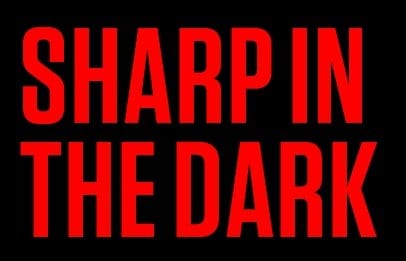A pale blue Cadillac with sparkling chrome hubcaps turned onto Fulgrove Street with its windows down. Donna Summer’s “On the Radio” played at full volume on the vehicle’s sound system. Pulsing bass beats vibrated through the frame of Sidney Sharp’s K-car and launched her clear out of her seat. “Huh?” she gasped, looking around and trying to remember where she was and what she was doing.
Up ahead, Mintz’s silver Ford stood parked at the side of the street. Right, thought Sharp. You followed him to the home of his lady friend. You’re on a case, remember? The Cadillac turned at the end of the street. There was a moment of silence before Sharp heard the first strains of “Love to Love You Baby.” He’s got the album on cassette, thought Sharp, who knew the track order by heart.
Dead leaves had settled on the Ford’s roof. They were rustling around, too, now that the wind had started.
Sharp peered upward, frowning. Purple-black clouds pushed across the grey dome of October sky. It looked like a dismal day was about to get even worse.
Sharp rubbed her face to wake up. She had to stop dozing off on the job. She looked at her watch. She’d been asleep for over an hour.
Meg would have said, “See?”
Sharp thought, bitterly, of her ex-girlfriend and winced, remembering their final argument — and Meg’s litany of complaints. She could hear Meg’s shrill voice, breaking, as she tried to make her point. “I find you so frustrating! You’re just not — present. You’re either thinking about something else or falling asleep! It’s just not normal. And I have no idea how you solve anything.” But for Sharp, her mind’s sleepy musings sometimes paid off. More than once, the answer to a case had come to her when her mind was drifting from topic to topic on its way to sleep.
But that was no consolation for Meg.
They broke up. Or rather, Meg broke up with Sharp. All Sharp’s relationships seemed to end quickly. A smile drifted across her face and a pang of desire coursed through her body: Claire. Claire would be different! She let her mind slide back to their night together . . . Her eyelids slipped shut.
Sharp shook herself. She had to stay alert. She had a report to file for Mrs Mintz with all the proof of her husband’s infidelity clearly outlined so that it could be used as evidence in court. Sharp took a Kodak Instamatic camera out of her kit bag. She climbed out of her car, walked along the sidewalk until she was directly opposite 141 Fulgrove and snapped a picture — then walked briskly back to her vehicle.
White, plastic blinds were pulled shut over the first-floor apartment’s windows. A Confederate flag covered the second floor’s bay window, and on the third floor, a pair of faded, rose-patterned curtains hung closed across the window. Or were they closed? She squinted, rubbed her eyes and looked up again. Now the curtains appeared to be slightly parted. Had they always been? Probably just the breeze, she thought to herself. Or, I’m losing my mind.
*
A newspaper lay folded on the seat beside her. Sharp picked it up and scanned the headlines: “Oil Exec Gets 10 Years,” “Raglan Road Fire Kills Three,” “East End Burglar Still At Large.” As usual, Toronto was full of crime, but none of it seemed to come her way. All she got were the cheaters.
A sad smile slid over her face. Tailing cheaters for a living. Well, thank god for them, right? They paid her bills. And it wasn’t an office job. There was always that consolation.
Her career started with a pack of matches. “Success Without College” was written across the front and on the other side, above the strike plate, a list of professions. Alongside “small engine repair,” “taxidermy” and other skill-based professions was printed “private detective.” Sharp liked the romantic and dangerous way it sounded. She liked the aloneness of it, too.
By correspondence, Sharp studied for eight weeks until a certificate arrived in the mail. With the last of her savings, she rented an office, framed her certificate and hung it on the wall. Sure, she did it without college, but as she waited, staring at 141 Fulgrove, the house Mintz had vanished into, she wasn’t so sure about the “success” part of the equation.
Droplets of rain hit the K-car’s windshield, slid down and disappeared.
Sharp flipped to the back page of her notebook and calculated her earnings. The Mintz fee would pay her October rent, which was two weeks overdue. Any money left over? Well, she’d use that for food. It sure was a great way to stay in shape. Just don’t eat. Sharp’s stomach rumbled. She took a sip of water from a plaid thermos. The cool water focused her mind. Almost. There was something she was forgetting. Was she supposed to be somewhere? She strained her mind, trying to imagine the small galley kitchen in her apartment, the pale-blue fridge in the corner — and the calendar attached to its door under the pressure of a truck-shaped orange magnet — a freebie from a neighbourhood carwash. She could picture the calendar and clearly see the October photo of a New Brunswick covered bridge against a backdrop of autumn foliage. But the little day box of information — what she really needed to see — was a fuzzy scribble.
The K-car was cold inside. She rubbed her hands together. A coffee right about now would be just the thing, she thought, knowing it wasn’t going to happen. An hour passed. The wind whipped funnels of leaves around her car. Inside, Sharp wiggled her toes and feet and patted her thighs to keep the blood moving. She pulled a blanket from the back seat and draped it over her.
She looked at her watch. 1:59 pm. Just five minutes of car battery wouldn’t hurt, she thought. She clicked on the radio. A news report was just starting. Sharp trained her eye on 141 Fulgrove, half listening. What is he doing in there? she wondered. The weather update flowed by her ears. What would a middle-class, middle-aged insurance man be doing in a Parkdale rooming house for four and a half hours? The international news flowed by her ears. Drugs? A prostitute? Visiting a client? The local news flowed by Sharp’s ears — and her eyes popped open. She grabbed the volume knob and cranked it.
“. . . a woman’s body was discovered this morning in a Crossley Street apartment. The police have not released the cause of death, though they have confirmed that a homicide investigation is underway. Turning to sports, the Leafs are looking for answers after a 12 to 3 routing by the Nordiques . . .”
“Crossley Street?” Sharp’s eyes widened. Her breath caught in her throat.
She threw off the blanket, turned the key in the ignition, popped the transmission into drive and pressed down hard on the gas. The K-car swerved out of its parking space and screeched off down the street.
The faded rose-patterned curtains in the third-floor window twitched open, wider, revealing the profile of Jeffrey Mintz. He leaned forward slightly and watched the K-car’s sudden departure on the street below.
A trace of fear flashed in his eyes.


 Why you can trust Xtra
Why you can trust Xtra


